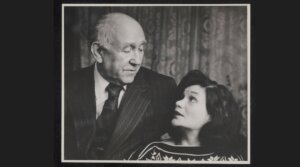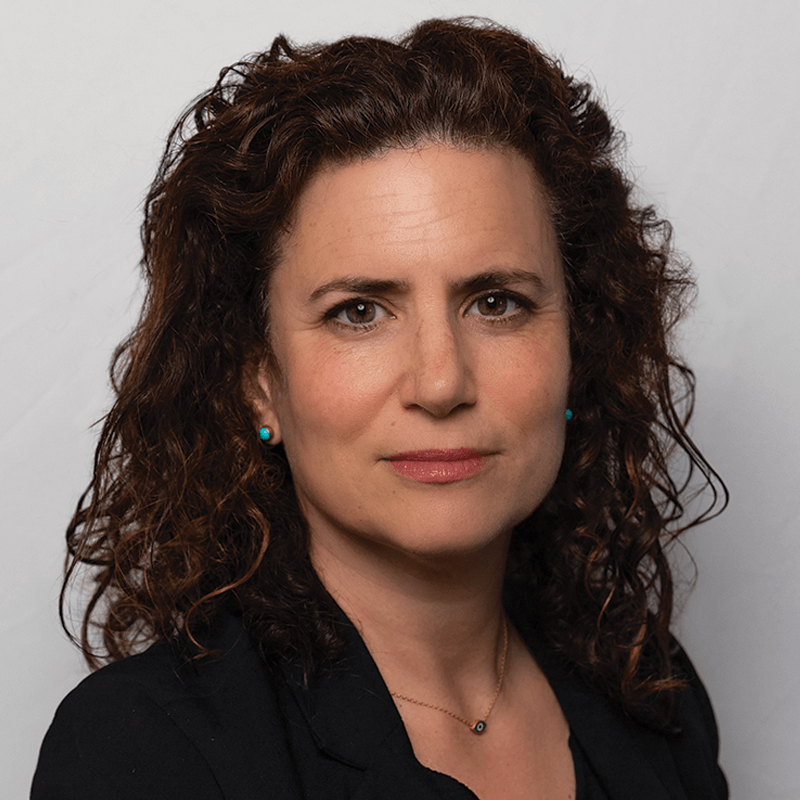Chaim Grade, author of ‘Sons and Daughters.’ Courtesy of Forward Association
Sons and Daughters
By Chaim Grade
Translated by Rose Waldman
Introduction by Adam Kirsch
Knopf, 685 pages, $35
At long last, Sons and Daughters.
The esteemed critic Harold Bloom, a native speaker of Yiddish, called Chaim Grade one of the four greatest writers in the Yiddish language. Sons and Daughters only solidifies Grade’s position in the pantheon of Yiddish culture. The theme of the novel, as Adam Kirsch suggests in his introduction, seems to be the perennial clash between religious parents and their sometimes rebellious offspring, a fixture of Yiddish literature at least since Tevye the Milkman contended with his headstrong daughters; the parents are destined to lose this struggle, because ultimately their opponent is modernity, and modernity is implacable.
The novel chronicles the disappointment parents often feel with their children, whose decisions and behavior ought to bring them nachas, or pride and gratification, but instead supply them with heartache. But Grade shows that these children suffer equally: unwilling or unable to abide by religious doctrine and dogma, yet thereby cut off from home and tradition; alienated from their families and ultimately themselves; leading lives as “rootless cosmopolitans,” as the Stalinists would ultimately charge them.
Kirsch calls the book “quite probably the last great Yiddish novel.” He may be right, and Sons and Daughters almost didn’t appear at all. Inna Hecker Grade, the famously difficult widow of Chaim Grade, signed a contract for the translation and publication of the novel over 40 years ago, in 1983, but soon cut off all contact with her editors at Knopf. After her death in 2010 and the lengthy probate, the Grades’ cluttered and disorganized apartment in the northwest Bronx was searched and the typeset Yiddish galleys were finally uncovered in 2014 by the YIVO Institute for Jewish Research and the National Library of Israel, which had been named the executors of the estate. Rose Waldman was hired to translate the novel in 2015.
Waldman had a difficult (and decade-long) task, as the book turned out to be unfinished. Grade labored for years to convert the two thousand pages of manuscript that he’d serialized in several Yiddish newspapers in the 1960s and 1970s into a publishable form. He complained to the journalist Morton A. Reichek that it would have been easier for him to begin another novel from scratch rather than condense Sons and Daughters (which was also, at various points, titled The Rabbi’s House).
The resulting abridgement, sensitively translated by Waldman and accompanied by a useful glossary of Yiddish and Hebrew terms, is unwieldy, uneven and unnerving; it’s also something of a masterpiece. With its swirling cast of characters, complicated family relationships, dissembling sons and daughters, and ambitious poets and clergymen, the novel is nearly Balzacian in scope, although its ambit is not the bustling Parisian metropolis of the first half of the 19th Century, but rather the band of small cities and shtetls along the banks of the Narew River near Bialystok, Poland, and extending east to Vilnius, where the borders of Poland, Lithuania, and Belarus all come together — a Comédie Humaine of Litvish life, circa 1930, i.e. the society of Orthodox (or previously Orthodox) Ashkenazi Jews who lived between the World Wars in the confines of what had once been the Grand Duchy of Lithuania.
The book begins with the family of the respected Rabbi Katzenellenbogen, who resides in Morehdalye, one of those Litvish shtetls. He has troubles with his adult children, including a son in Switzerland who hasn’t been heard from in years. Later we meet Katzenellenbogen’s father-in-law, another rabbi, Eli-Leizer, who has even bigger problems with his children, especially his increasingly bellicose son Shabse-Shepsel, a religious zealot, troublemaker, joker, mimic, and madman.
The compelling Shabse-Shepsel, who begins to take over the narrative, is an inspired creation, so embittered by the lack of love he’s perceived from his father that he’s determined to destroy his family, all while proclaiming himself his father’s great defender. He is equally determined to destroy his wife, Draizel, and his cruelty towards her is shocking and boundless; at times I read the book holding my breath, as the depiction of Shabse-Shepsel’s marriage must be one of the greatest bad marriages in world literature.
In a later section, we meet Naftali Hertz, the secular Katzenellenbogen son who left for Switzerland. We learn that his wife is Gentile, and he has an uncircumcised son. He hasn’t communicated with his parents because he doesn’t want them to find out, he feels estranged from his wife and child, and he’s guilt-ridden at leaving Judaism. In the final section, the various plot strands come together and the Polish-Lithuanian Jewish communities face deep economic decline, as roving bands of bojówkas, or Polish paramilitary units, enforce a boycott of Jewish businesses.
The unfinished novel ends somewhat abruptly and on a curious note. (This won’t be a spoiler.) Naftali Hertz is reminded of a polar bear in the Basel Zoo, who hangs a paw dangerously over a chasm in his pen, then retreats, then edges forward again, then retreats again. It’s a disquieting metaphor for Naftali’s own predicament and the role of an assimilated Jew in modern society, the “deathly fear” and the “wild desire” of living between two worlds, at home in neither. Grade knew well that feeling of dislocation: “I and many others of my generation remain dangling between two boundaries,” he once wrote.
Rose Waldman includes a brief synopsis of what Grade intended as the ultimate conclusion of the novel, but I found the existing ending oddly satisfying.

Grade felt duty-bound to eulogize the religious communities of Eastern European Jewry that were eradicated by the Nazis. “I have the feeling that it is the will of God for me to leave a monument for a world that perished,” he told Reichek. “I don’t want to seem melodramatic, but I’ve always felt that I remained alive to be able to describe what our life had been like.” And he wrote his friend Abraham Bornstein, “I feel I owe this book [Sons and Daughters] to the Jewish people… It’s constantly strange to me. I have so little faith, and yet I believe with complete faith that Providence saved me and allowed me to live to immortalize the great generation I knew.”
He was torn between his religious upbringing and early inculcation into the Musar movement, an extreme, pious, ascetic sect of Judaism that focused on ethics, virtue, and self-improvement, and his rebellion against those pietist constraints; in the 1930s he would join Young Vilna, a free-thinking and sometimes earthy group of left-wing, humanistic, and secular poets and artists committed to developing Yiddish culture. (“The street and the prayer house are like twins to me,” a character notes in Sons and Daughters.) When the Nazis were about to invade Vilnius, Grade fled east into Soviet Russia and then Central Asia; his mother and first wife, who thought they were safe and stayed behind, were murdered in the Holocaust.
After the war, Grade moved with his second wife to the Bronx, where he lived for the next 35 years, until his death. A secular Jew who enjoyed Burger King Whoppers, and who generally avoided synagogue, even during the High Holidays, Grade would nevertheless don a yarmulke when re-reading the work of the Vilna Gaon, a famed Talmudic scholar from the 19th Century. Grade’s many volumes of poetry cover a wide gamut of human experience, but his prose is more circumscribed, almost exclusively charting the lives of rabbis and their wives, students, and congregants. “In poetry, I am universal; in prose, thoroughly Jewish-traditional,” he wrote Bornstein, a Boston dealer of art books.

What Grade’s neighborhood in the Bronx gave him was a community of Yiddish speakers who were still alive, still able to communicate with him. I grew up a few blocks from Grade (I never met him) in the 1970s, and I can attest that Yiddish speakers, while certainly a minority, had a significant presence in Van Cortlandt Village: the Yiddishists, socialists, and communists living in the Sholem Aleichem houses, where Bess Myerson, the first Jewish Miss America, grew up; the immigrants and labor organizers in the so-called “needle trades” residing in the Amalgamated Housing Cooperatives, built by the Amalgamated Clothing Workers Union; other Holocaust survivors who’d settled in the neighborhood, like the parents of two of my friends; and the aging Bundists meeting in the nearby Workers (originally Workmen’s) Circle hall and offering classes in Yiddish to neighborhood children. He had an audience, a small one to be sure, which he supplemented with his frequent lecture tours to Yiddish-speaking communities throughout the United States and Canada; these lectures were the primary source of his income. Unlike Isaac Bashevis Singer, he never learned to speak English well, which cost him dearly in the marketplace; the advantage was that his Yiddish remained vital.
With its complicated characters, beautiful descriptions of the Polish-Lithuanian countryside, and eccentric, perplexing metaphors, the writing in Sons and Daughters is vivid and memorable. The characters are continually likened to birds and vegetation, and contrarily, nature is likened to mankind. Clouds crawl low and quiet, “like barefoot thieves stealing laundry from attics.” A rabbi’s daughter has “the swollen figure of a water-logged cucumber.” A pair of beds, piled with linen, looks like two tired doves.
In the end, Sons and Daughters, though hardly didactic, offers the hope of a peaceful synthesis of spirituality and secular life and an implicit criticism of zealotry and extremism. I read the novel while a fragile truce held in Gaza. A permanent peace seems a long way off, if it’s possible at all, and a recent Gallup poll found that two-thirds of Israelis as well as two-thirds of Palestinians currently oppose a two-state solution. For now, the zealots like Shabse-Shepsel have won.
#

I hope you appreciated this article. Before you go, I’d like to ask you to please support the Forward.
At a time when other newsrooms are closing or cutting back, the Forward has removed its paywall and invested additional resources to report on the ground from Israel and around the U.S. on the impact of the war, rising antisemitism and polarized discourse.
Readers like you make it all possible. We’ve started our Passover Fundraising Drive, and we need 1,800 readers like you to step up to support the Forward by April 21. Members of the Forward board are even matching the first 1,000 gifts, up to $70,000.
This is a great time to support independent Jewish journalism, because every dollar goes twice as far.
— Rachel Fishman Feddersen, Publisher and CEO
